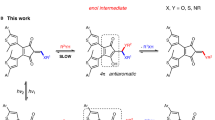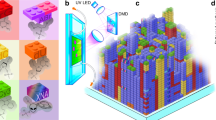Abstract
The click reaction paradigm is focused on the development and implementation of reactions that are simple to perform while being robust and providing exquisite control of the reaction and its products. Arguably the most prolific and powerful of these reactions, the copper-catalysed alkyne–azide reaction (CuAAC) is highly efficient and ubiquitous in an ever increasing number of synthetic methodologies and applications, including bioconjugation, labelling, surface functionalization, dendrimer synthesis, polymer synthesis and polymer modification. Unfortunately, as the Cu(I) catalyst is typically generated by the chemical reduction of Cu(II) to Cu(I), or added as a Cu(I) salt, temporal and spatial control of the CuAAC reaction is not readily achieved. Here, we demonstrate catalysis of the CuAAC reaction via the photochemical reduction of Cu(II) to Cu(I), affording comprehensive spatial and temporal control of the CuAAC reaction using standard photolithographic techniques. Results reveal the diverse capability of this technique in small molecule synthesis, patterned material fabrication and patterned chemical modification.
This is a preview of subscription content, access via your institution
Access options
Subscribe to this journal
Receive 12 print issues and online access
$259.00 per year
only $21.58 per issue
Buy this article
- Purchase on Springer Link
- Instant access to full article PDF
Prices may be subject to local taxes which are calculated during checkout




Similar content being viewed by others
References
Kolb, H. C., Finn, M. G. & Sharpless, K. B. Click chemistry: diverse chemical function from a few good reactions. Angew. Chem. Int. Ed. 40, 2004–2021 (2001).
Spruell, J. M. et al. Heterogeneous catalysis through microcontact printing. Angew. Chem. Int. Ed. 47, 9927–9932 (2008).
Peng, W. et al. Efficiency and fidelity in a Click—chemistry route to triazole dendrimers by the copper(I)-catalyzed ligation of azides and alkynes. Angew. Chem. Int. Ed. 43, 3928–3932 (2004).
DeForest, C. A., Polizzotti, B. D. & Anseth, K. S. Sequential Click reactions for synthesizing and patterning three-dimensional cell microenvironments. Nature Mater. 8, 659–664 (2009).
Matyjaszewski, K. & Tsarevsky, N. V. Nanostructured functional materials prepared by atom transfer radical polymerization. Nature Chem. 1, 276–288 (2009).
Iha, R. K. et al. Applications of orthogonal ‘Click’ chemistries in the synthesis of functional soft materials. Chem. Rev. 109, 5620–5686 (2009).
Wang, Q. et al. Bioconjugation by copper(I)-catalyzed azide-alkyne [3 + 2] cycloaddition. J. Am. Chem. Soc. 125, 3192–3193 (2003).
El-Sagheer, A. H. & Brown, T. Click chemistry with DNA. Chem. Soc. Rev. 39, 1388–1405 (2010).
Macpherson, L. J. et al. Noxious compounds activate TRPA1 ion channels through covalent modification of cysteines. Nature 445, 541–545 (2007).
Cohen, M. S., Hadjivassiliou, H. & Taunton, J. A clickable inhibitor reveals context-dependent autoactivation of p90 RSK. Nature Chem. Biol. 3, 156–160 (2007).
Bowman, C. N. & Kloxin, C. J. Toward an enhanced understanding and implementation of photopolymerization reactions. AICHE J. 54, 2775–2795 (2008).
Hoyle, C. E. & Bowman, C. N. Thiol-ene Click chemistry. Angew. Chem. Int. Ed. 49, 1540–1573 (2010).
Fodor, S. P. A. et al. Light-directed, spatially addressable parallel chemical synthesis. Science 251, 767–773 (1991).
Koh, W.-G., Revzin, A. & Pishko, M. V. Poly(ethylene glycol) hydrogel microstructures encapsulating living cells. Langmuir 18, 2459–2462 (2002).
Martens, P. J., Bryant, S. J. & Anseth, K. S. Tailoring the degradation of hydrogels formed from multivinyl poly(ethylene glycol) and poly(vinyl alcohol) macromers for cartilage tissue engineering. Biomacromolecules 4, 283–292 (2003).
Neckers, D. C. Architecture with photopolymerization. Polym. Eng. Sci. 32, 1481–1489 (1992).
Young, J. S., Fox, S. R. & Anseth, K. S. A novel device for producing three-dimensional objects. J. Manuf. Sci. Eng. 121, 474–477 (1999).
Long, D. A. et al. Localized ‘Click’ chemistry through dip-pen nanolithography. Adv. Mater. 19, 4471–4473 (2007).
Paxton, W. F., Spruell, J. M., and Stoddart, J. F. Heterogeneous catalysis of a copper-coated atomic force microscopy tip for direct-write Click chemistry. J. Am. Chem. Soc. 131, 6692–6694 (2009).
Rozkiewicz, D. I. et al. ‘Click’ chemistry by microcontact printing. Angew. Chem. Int. Ed. 45, 5292–5296 (2006).
Devaraj, N. K., Dinolfo, P. H., Chidsey, C. E. D. & Collman, J. P. Selective functionalization of independently addressed microelectrodes by electrochemical activation and deactivation of a coupling catalyst. J. Am. Chem. Soc. 128, 1794–1795 (2006).
Hansen, T. S., Daugaard, A. E., Hvilsted, S. & Larsen, N. B. Spatially selective functionalization of conducting polymers by ‘electroclick’ chemistry. Adv. Mater. 21, 4483–4486 (2009).
Qin, D., Xia, Y. N. & Whitesides, G. M. Rapid prototyping of complex structures with feature sizes larger than 20 µm. Adv. Mater. 8, 917–919 (1996).
Padwa, A. Intramolecular 1,3-dipolar cycloaddition reactions. Angew. Chem. Int. Ed. Engl. 15, 123–136 (1976).
Poloukhtine, A. A. et al. Selective labeling of living cells by a photo-triggered Click reaction. J. Am. Chem. Soc. 131, 15769–15776 (2009).
Orski, S. V. et al. High density orthogonal surface immobilization via photoactivated copper-free Click chemistry. J. Am. Chem. Soc. 132, 11024–11026 (2010).
Meldal, M. Polymer ‘clicking’ by CuAAC reactions. Macromol. Rapid Commun. 29, 1016–1051 (2008).
Sakamoto, M., Tachikawa, T., Fujitsuka, M. & Majima, T. Three-dimensional writing of copper nanoparticles in a polymer matrix with two-color laser beams. Chem. Mater. 20, 2060–2062 (2008).
Kasuga, Y. et al. Kinetic study on Huisgen reaction catalyzed by copper (I): triazol formation from water-soluable alkyne and alkyl azide. Heterocycles 78, 983–997 (2009).
Johnson, J. A., Finn, M. G., Koberstein, J. T. & Turro, N. J. Construction of linear polymers, dendrimers, networks, and other polymeric architectures by copper-catalyzed azide–alkyne cycloaddition ‘Click’ chemistry. Macromol. Rapid Commun. 29, 1052–1072 (2008).
Fairbanks, B. D. et al. Thiol-yne photopolymerizations: novel mechanism, kinetics, and step-growth formation of highly cross-linked networks. Macromolecules 42, 211–217 (2009).
Malkoch, M. et al. Synthesis of well-defined hydrogel networks using Click chemistry. Chem. Commun. 2774–2776 (2006).
Ribeiro, A. C. F. et al. Diffusion coefficients of copper chloride in aqueous solutions at 298.15 K and 310.15 K. J. Chem. Eng. Data 50, 1986–1990 (2005).
Litter, M. I. Heterogeneous photocatalysis—transition metal ions in photocatalytic systems. Appl. Catal. B 23, 89–114 (1999).
Zhan, W., Seong, G. H. & Crooks, R. M. Hydrogel-based microreactors as a functional component of microfluidic systems. Anal. Chem. 74, 4647–4652 (2002).
Ofir, Y. et al. Nanoimprint lithography for functional three-dimensional patterns. Adv. Mater. 22, 3608–3614 (2010).
Wang, J.-S. & Matyjaszewski, K. ‘Living’/controlled radical polymerization. Transition-metal-catalyzed atom transfer radical polymerization in the presence of a conventional radical initiator. Macromolecules 28, 7572–7573 (1995).
Kloxin, A. M., Kasko, A. M., Salinas, C. N. & Anseth, K. S. Photodegradable hydrogels for dynamic tuning of physical and chemical properties. Science 324, 59–63 (2009).
Acknowledgements
The authors acknowledge financial support from the US Department of Education's Graduate Assistantship in Areas of National Need (B.J.A., C.A.D.), Sandia National Labs (B.J.A.) and the National Science Foundation (grant CBET 0933828, C.J.K.).
Author information
Authors and Affiliations
Contributions
C.N.B., C.J.K. and B.J.A. developed the concept. B.J.A., Y.T., C.J.K., C.A.D., K.S.A. and C.N.B. designed the experiments. C.A.D. synthesized the materials used. B.J.A., Y.T. and C.A.D. performed the experiments. B.J.A., C.J.K., K.S.A. and C.N.B. composed the manuscript.
Corresponding author
Ethics declarations
Competing interests
The authors declare no competing financial interests.
Supplementary information
Supplementary information
Supplementary information (PDF 364 kb)
Rights and permissions
About this article
Cite this article
Adzima, B., Tao, Y., Kloxin, C. et al. Spatial and temporal control of the alkyne–azide cycloaddition by photoinitiated Cu(II) reduction. Nature Chem 3, 256–259 (2011). https://doi.org/10.1038/nchem.980
Received:
Accepted:
Published:
Issue Date:
DOI: https://doi.org/10.1038/nchem.980
This article is cited by
-
Sensitizer-enhanced two-photon patterning of biomolecules in photoinstructive hydrogels
Communications Materials (2022)
-
Red light-induced conjugation of amines through amide bond formation triggered via photooxidation of 3-acylindolizines
Communications Chemistry (2022)
-
Spatiotemporal patterning of photoresponsive DNA-based hydrogels to tune local cell responses
Nature Communications (2021)
-
A comparison of RAFT and ATRP methods for controlled radical polymerization
Nature Reviews Chemistry (2021)
-
Ionic amplifying circuits inspired by electronics and biology
Nature Communications (2020)



